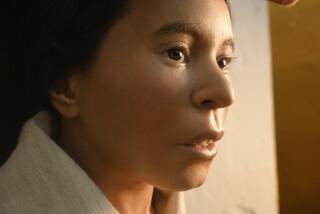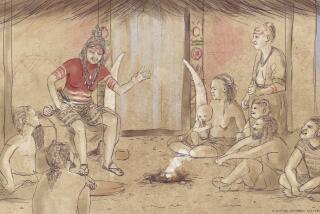9,000-year-old decapitation victim hints at ‘sophisticated’ society
An international team of scientists says they’ve discovered the oldest known beheaded skull in the Americas – arranged in a strange, possibly symbolic pose.
The skull, described in the journal PLOS ONE, was found in a rock shelter at an archaeological site in east-central Brazil known as Lapa do Santo. The skull, which appears to have belonged to a young man, was discovered in a grave nearly 22 inches beneath the surface, over which limestone slabs had been placed. It is estimated to be between 9,127 and 9,438 years old.
“This is the oldest case of decapitation found in the New World, leading to a re-evaluation of the previous interpretations of this practice, particularly with regards to its origins and geographic dispersion,” the study authors wrote.
And it wasn’t alone: The skull’s face was covered with the bones of two amputated hands, palms facing inward. The right hand covered the left side of the face, fingers pointed at the chin; the left hand covered the right side of the face with fingers pointing to the forehead.
“This is a very unique find ... this is the only one we ever found that has this type of symbolic, of ritual, processes,” said study coauthor Mark Hubbe, a bioarchaeologist at Ohio State University. “We don’t know where the rest of the body is -- which is part of the mystery, I guess.”
Previous instances of beheading go back as far back as 3,000 years ago in South America, and they all occur in the ancient populations that lived in the area of the Andes Mountains. This discovery from Brazil shows that the practice may have emerged in other parts of South America as well.
See the most-read Science stories this hour >>
“The careful arrangement of the hands over the face is compatible with an important public display component in the ritual that could have worked to enhance social cohesion within the community,” the authors wrote. “This ritualized burial attests to the early sophistication of mortuary rituals among hunter-gatherers in the Americas.”
Human skulls in the South American civilizations were performed for a variety of reasons, which varied from culture to culture; some would use them as a display of military might, beheading their enemies and turning the skulls into ornaments or drinking vessels; others used it as a form of ritual sacrifice within their own community.
This skull, on the other hand, was found in present-day Brazil, far to the east of the Andes. And it doesn’t seem to match those descriptions. For one thing, this was probably not an outsider who was attacked during a battle, because the analysis of strontium isotopes in the tooth enamel connected him to other local residents.
A trophy head would usually have been modified in some way -- it might have been drilled, or the hole at the base of the skull that’s meant for the spinal cord might have been enlarged in order to remove the brain (as a decomposing organ would probably make a messy, smelly trophy). But no such marks are found on this skull. Cross the “trophy” theory out.
Though it’s hard to say for sure, this decapitation may have been part of some burial ritual, the authors say. Certainly the positioning of the hands seems to be filled with meaning – right hand on the left side, left on the right, pointing in opposite directions.
“We suggest a ritualized decapitation instead of trophy-taking, testifying for the sophistication of mortuary rituals among hunter-gatherers in the Americas during the early Archaic period,” the study authors wrote. “In the apparent absence of wealth goods or elaborated architecture, Lapa do Santo’s inhabitants seemed to use the human body to express their cosmological principles regarding death.”
But what was the meaning behind those rituals? Why the decapitation, and the carefully placed hands?
“To be super honest, we have no clue because we’re talking about people who lived there 9,000 years ago,” Hubbe said. “So it’s safe to assume they had a whole different set of beliefs, a whole different way to see life and to see death.”
Follow @aminawrite on Twitter for more science news.
ALSO:
Longer fasts might help with weight loss but Americans eat all day long
Planning to retire? Seniors who keep working are healthier, study says
One in 10 pregnant women admits to drinking, including binge drinking







